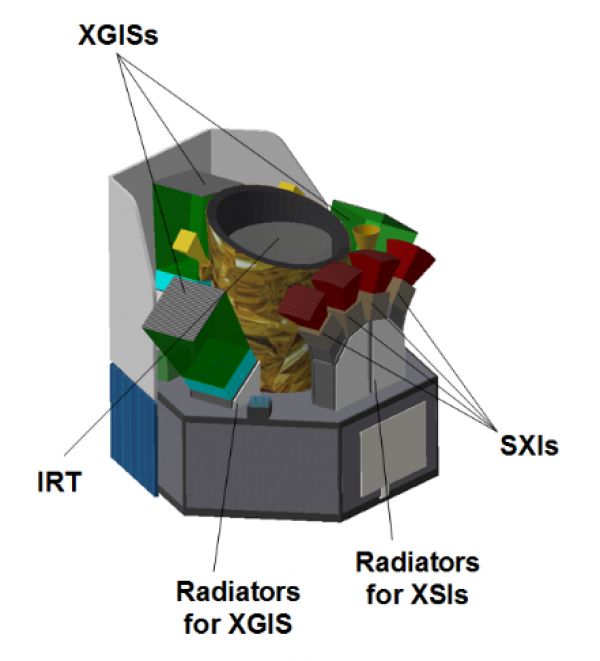On May 7, 2018, the European Space Agency (ESA) announced the three selected space missions, out of the 25 proposed, for the fifth ESA middle class mission in its scientific program Cosmic Vision, whose launch date is planned in 2032. One of these three missions is the THESEUS project (Transient High-Energy Sky and Early Universe Surveyor), a project developed in recent years by a large European consortium in which the Astrophysics Department-AIM Laboratory of CEA-Irfu plays a major role. THESEUS aims to explore the early Universe (the first billion years) through gamma ray bursts (GRBs), the most extreme explosions of the cosmos, and to provide accurate detection, localization, and distance measurement of gravitational waves and neutrinos sources, as well as many other transient celestial sources.
A versatile mission
The THESEUS mission should make it possible to fully exploit the great potential of gamma ray bursts (GRB) for cosmological purposes, especially for the study of the primordial universe, and it will also make a fundamental contribution to multi-messenger and temporal astrophysics. THESEUS will thus make a unique and fundamental contribution to several fields of astrophysics, cosmology and fundamental physics, and it will work in synergy with the major global installations planned for the next decade and dedicated to the study of the cosmos, such as as LSST (Large Synoptic Survey Telescope), ELT (Extremely Large Telescope), SKA (Square Kilometer Array), CTA (Cherenkov Telescope Array), ATHENA, aLigo (Advanced LIGO), aVirgo (Advanced VIRGO), Kagra (Large-scale Cryogenic Gravitational wave Telescope) and Km3NeT (Cubic Kilometre Neutrino Telescope), thus significantly improving their scientific return.
THESEUS will also function as a more versatile and flexible observatory in the field of infra red and X-rays, providing NASA's Swift mission with increased opportunities for the astrophysical community.

The two main objectives of the THESEUS mission and their synergy with other major terrestrial and space programs. On the left: the exploration of the young universe thanks to the gamma-ray bursts detection (GRB) will complete the expected results of the ELT and Athena projects. On the right: the location of gravitational wave sources in synergy with the ELT (visible light), Athena (X-ray) and SKA (radio waves) missions.
A competition for a decision in 2021
The selection of THESEUS by ESA demonstrates the unique expertise and capacity of Europe and France, in particular the CEA Astrophysics Department-AIM Laboratory and LAM (Laboratory of Astrophysics of Marseille), GEPI (Galaxies, stars, physics and instrumentation) and IRAP (Institute for Research in Astrophysics and Planetology) laboratories, in the frontier fields of modern astrophysics and cosmology, as well as in key innovative technologies.
An international consortium led by France and in particular by the Astrophysics Department-AIM Laboratory of CEA-Irfu and the Laboratory of Astrophysics of Marseille (LAM) will be responsible in collaboration with the CNES (National Center for Space Studies) for the supply of the IRT camera (InfaRed Telescope), a sensitive spectro-imager in the near-infrared range.
The THESEUS mission was proposed to ESA in 2016 and is being studied as the fifth medium-sized mission (M5) in ESA's Cosmic Vision program. THESEUS was selected with two other missions SPICA (SPace Infrared telescope for Cosmology and Astrophysics) and EnVision (mission to the planet Venus), among 25 proposals submitted to ESA. The medium-sized M ESA missions have a budget of € 550 million, with contributions from ESA member states and other countries. The final decision on which mission to select for launch as M5 will be taken in 2021.
Contact : Diego GOTZ
See also : the ESA Pres Release (7 mai 2018)
• Structure and evolution of the Universe › High energy cosmic phenomena and astroparticles Thèmes de recherche du Service d'astrophysique › Instrumentation-SAp
• The Astrophysics Division (DAp)
• High Energy Cosmic Phenomena Research Laboratory
• THESEUS




